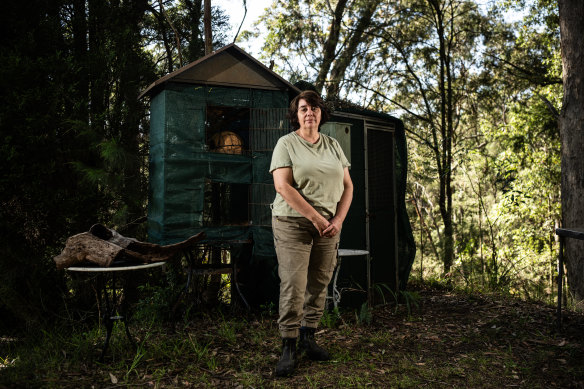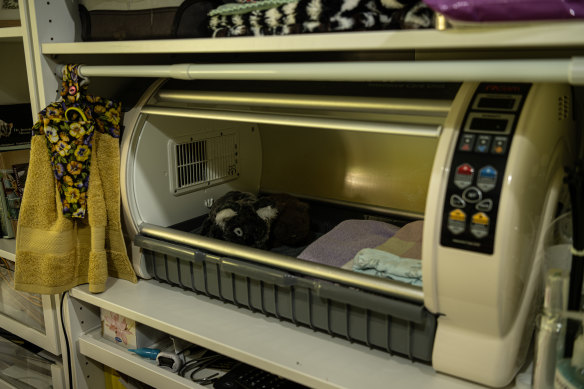- Exclusive
- Environment
- Conservation
- Wildlife
This was published 5 months ago
WIRES risks mass exodus as internal warfare comes to a head
After a decade as a wildlife rescue carer, Liz Martin resigned this week from volunteering with WIRES, demoralised by what she sees as a war by head office on its own members.
The wildlife cages at her home in north-west Sydney have provided shelter to more than 400 possums and gliders over the years. Now they stand empty and five ringtail possums that recently returned to the wild will be the last batch she fosters.

Liz Martin, a former WIRES carer who has left the organisation after 10 years, standing before now-empty rehabilitation cages for possums and gliders.Credit: Nick Moir
Martin feels that the current regime at WIRES is “no longer focused on treating volunteers with respect”.
“They consider us disposable, and they’ve just undercut the value of what we do, which is what the public sees and values and supports us for,” Martin said.
“They say you’re bringing the organisation into disrepute if you speak out, which is what I will be dealing with, but I think it’s too late for me, I can’t keep going.”
Martin, who is using her maiden name to protect her family’s privacy, is one of more than 900 WIRES members who have not accepted a new constitution rammed through by head office as part of its switch from an association to a company.

The now empty rehabilitation humidicrib that Liz Martin used for baby possums and gliders.Credit: Nick Moir
That leaves more than a quarter of the WIRES membership in legal limbo because they did not click a link to remain part of the organisation and accept the constitution, yet are authorised to care for wildlife only through their membership.
Martin is not the only carer who is either giving up for good or temporarily not taking rescue animals until they are sure of their legal standing and access to insurance. This comes in spring when rescues are higher than other times of year because it’s breeding season, and as Australia braces for an avian flu that has devastated wildlife elsewhere in the world.
Meanwhile, WIRES, the largest and richest wildlife rescue organisation in Australia, is yet to spend about $69 million of the $102 million raised from all around the world to help care for wildlife during the 2019-20 Black Summer bushfires, and part of the constitutional change will reduce the oversight over that money.
NSW Environment Minister Penny Sharpe announced a review of the state’s wildlife rehabilitation sector in May, but this is not yet complete. WIRES declined to comment for this story, and NSW National Parks and Wildlife Service said it was a matter for WIRES.
Many members objected to the new constitution because they say it eroded the rights of volunteers. It creates two tiers of volunteers – members with voting rights who do not have to be carers and authorised persons who can care for wildlife under the WIRES licence but do not get input as members.
The new constitution limits the right of members to inspect financial records and requires them to pay any fee set by the organisation. It also requires members to reapply every year rather than simply allowing them to renew, which could allow members to be expelled without being guilty of wrongdoing.
Luke Stefko, a wildlife rescue carer from Merimbula on the South Coast, said he believes WIRES is “morphing into a law enforcement agency”.
“If they think that one of their members is not performing or doing the right thing, rather than, say, provide extra training, encouragement and a more supportive environment, they’re going after them to prosecute them,” Stefko said.
This masthead has documents from a case two years ago when another member of Stefko’s branch was caring for a seabird that had been found with a fishing hook in its wing. The bird eventually died, sparking a WIRES investigation and some months later, an RSPCA prosecution for animal cruelty. The case was dropped but her membership of WIRES remains suspended.
A separate case where a wildlife carer is accused of animal cruelty comes before Katoomba Local Court next week.
This masthead has spoken to many other volunteers who are scared to speak out publicly for fear of having their animals removed, having their status as a carer revoked, being sued for defamation, or being prosecuted by the RSPCA.
A number of senior people at WIRES formerly worked at the RSPCA, including at least three in the wildlife welfare enforcement team. An RSPCA spokesperson said there had been three investigations involving WIRES volunteers since 2020; of those one matter remains before the court, one is finalised and the other did not result in enforcement action.
The NSW Department of Fair Trading required WIRES to change from an association to a company limited by guarantee, in part because of its financial assets.
The change in corporate structure also meant the organisation had to adopt a new constitution, which would normally require the approval of 75 per cent of members. However, the constitution that was registered at the Australian Securities and Investment Commission and previous versions were rejected by members at three separate meetings.
At the most recent special general meeting in July, the board-endorsed constitution received 56 per cent of votes, while an alternative put forward by some members received 48 per cent of votes.
WIRES did secure 96 per cent support to change to a company structure. Upon lodging its paperwork at ASIC, WIRES registered its preferred constitution without calling a fourth vote.
In an email to members, WIRES said it had decided to do this to spare them from voting again, and told people to click on a link to agree to the new constitution if they wanted to remain as members.
ASIC, the corporate regulator, approved WIRES’ transition to a company in late September.
WIRES documents suggest 904 members voted at the special general meeting, representing 29 per cent of the broader membership. That implies a total membership of 3117 at the time, while previous reports to the charity’s regulator listed a membership of 4000.
In an email to members, the WIRES board said 2203 volunteers consented to be members at the time of the corporate registration. The letter acknowledged another 108 people sent letters saying they wished to remain members but did not agree to the constitution, and said these people could continue as authorised members.
That leaves 806 people who did not consent to be members and did not send a letter whose status is now unclear. In some branches, this includes most office holders.
To legally care for wildlife, you have to either have an individual licence from NPWS, only available in exceptional circumstances, or you join a wildlife rescue organisation and receive authorisation under their licence.
In Greater Sydney, there is one other licensed group, Sydney Wildlife Rescue. In most of NSW, WIRES has a monopoly.
Get to the heart of what’s happening with climate change and the environment. Our fortnightly Environment newsletter brings you the news, the issues and the solutions. Sign up here.